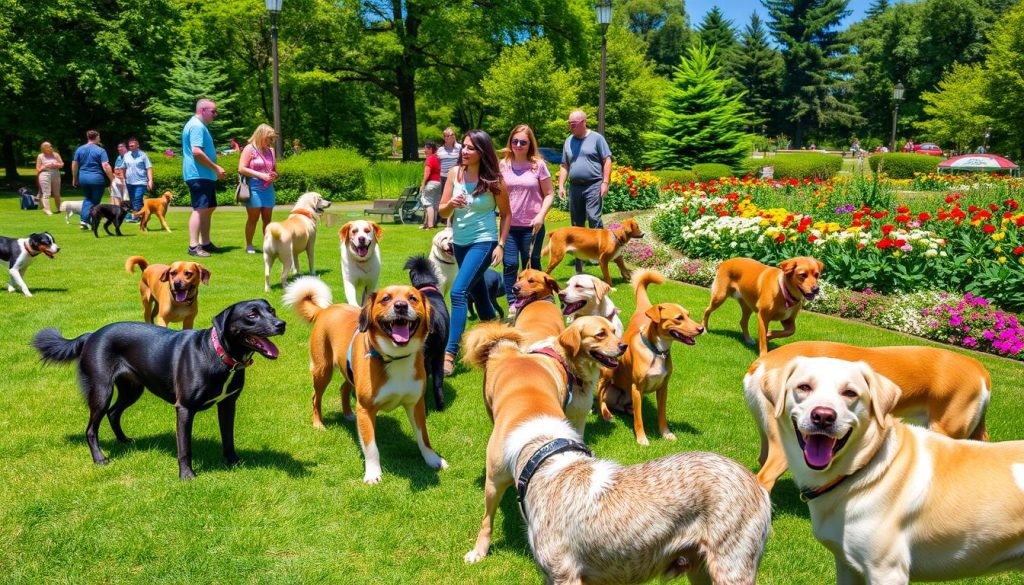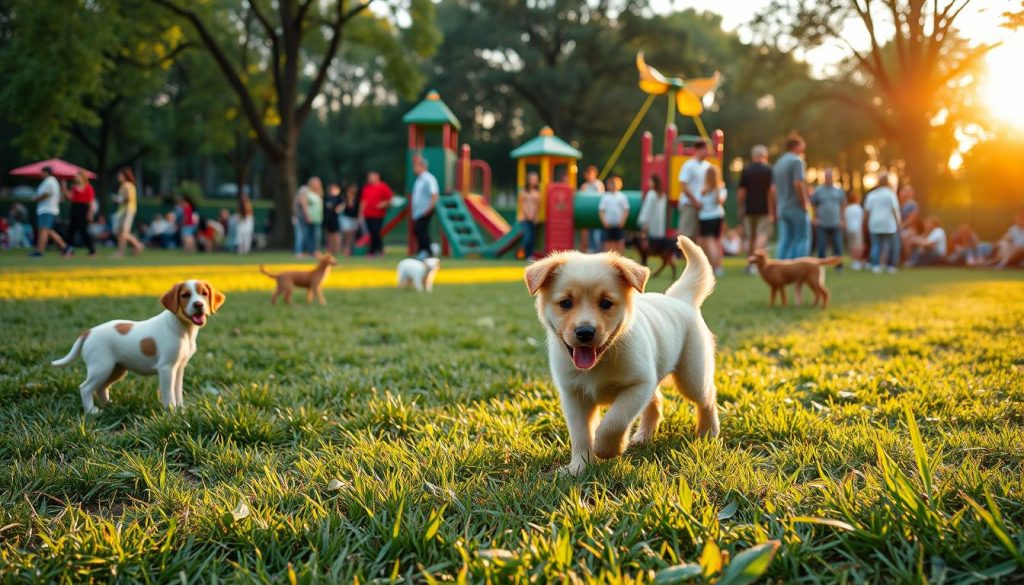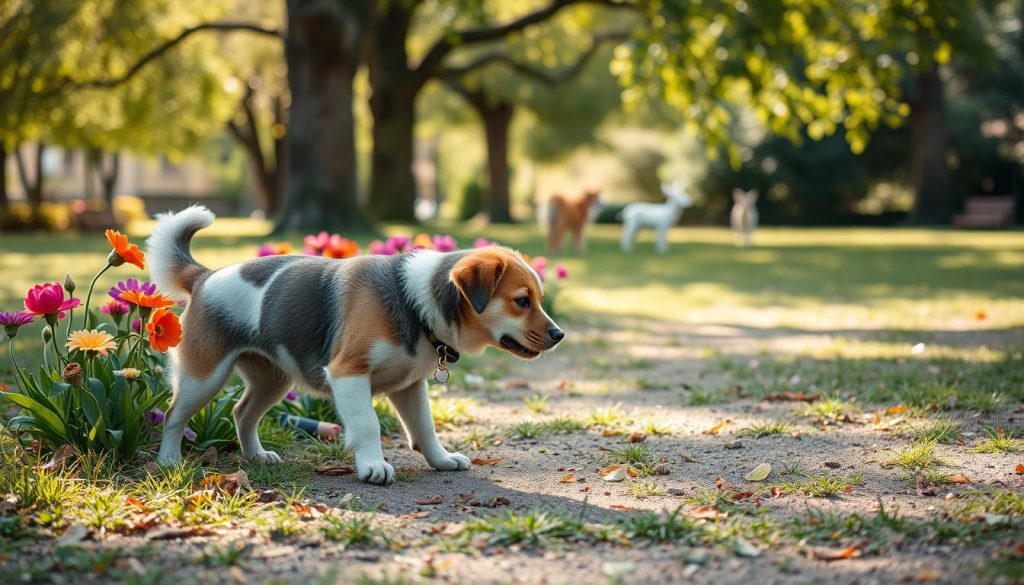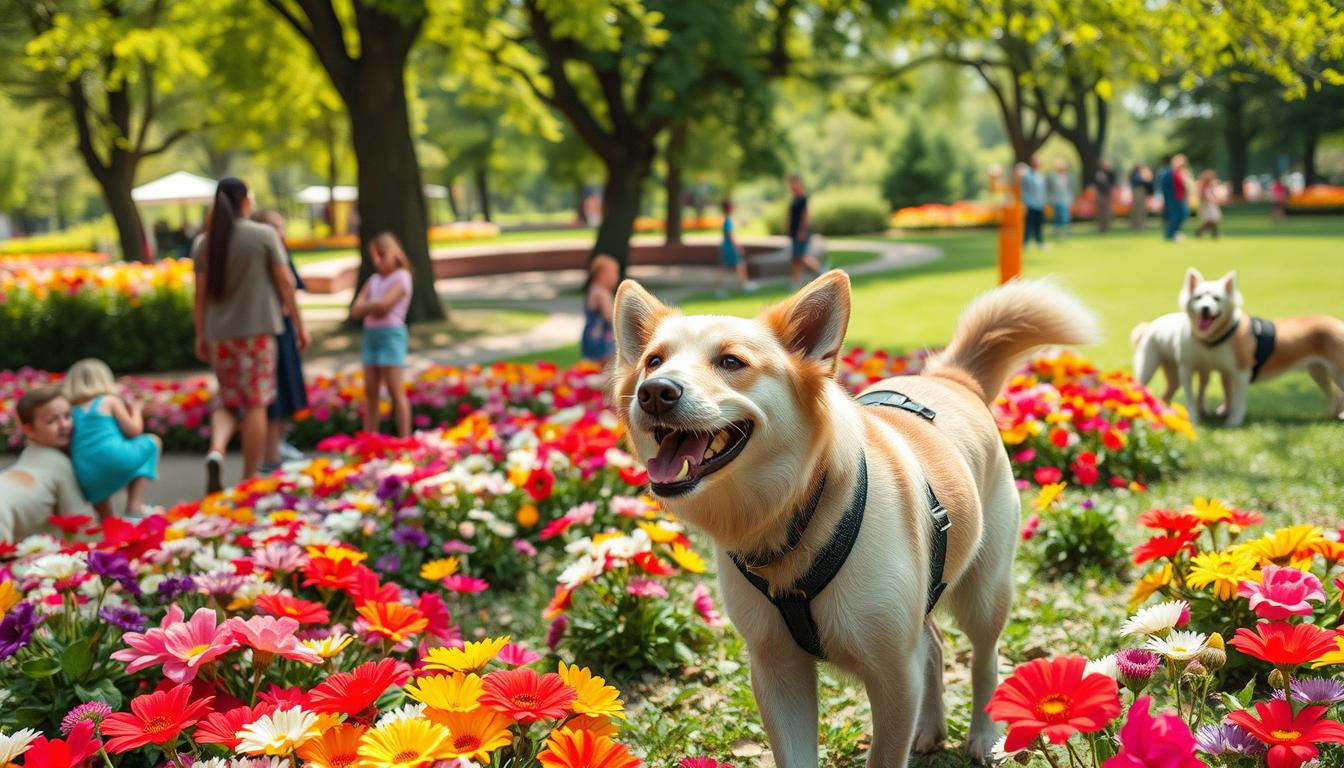Have you ever seen dogs that are calm in new places, while others seem scared or nervous? It’s often because of socialization. Learning how to introduce your dog to new things is key for their happiness and well-being.
Socializing your dog means more than just meeting other dogs. It’s about getting them used to people, animals, places, and situations. This is important for their behavior and life quality. But, how do you make sure they have good experiences?
Keep reading to learn the best ways to socialize your dog. We’ll show you how to make your dog confident and happy in new situations.
Why Socialization is Crucial for Your Dog
It’s vital to understand how crucial socialization is for your dog. Early exposure to different situations helps in their behavioral growth. This makes them more adaptable and less anxious in new places. It’s key to start with positive social experiences early on.
Introducing your dog to various environments, people, and animals helps them learn important social skills. This leads to a calmer and less stressful life. It makes everyday moments with your dog more fun for both of you.

Quick Recommendation : Our blog is filled with tips , tricks, and methods for training your dog. If you are seeking a comprehensive training program, we recommend the K9 Training Institute.
Good socialization does more than just make your dog friendly. It gives them the skills they need to handle the world with confidence. By focusing on their growth, you improve their happiness and deepen your connection with them.
Understanding the Socialization Period in Puppies
Bringing a new puppy home means starting their socialization early. The key time for this is between three to fourteen weeks old. It’s when they’re most open to new things, making it great for introducing them to the world.

This period is crucial for your puppy’s growth into a well-adjusted adult dog. It’s important to expose them to different people, animals, sounds, and textures. This helps prevent fear and builds a strong base for positive interactions.
Knowing how to make the most of this time helps avoid future behavior problems. Every puppy’s early experiences shape their confidence and how they interact with others. By focusing on socializing your puppy well, you’re helping them have a good life and fit in with others.
Benefits of Socializing Your Dog
Socializing your dog has many benefits that go beyond just training. It greatly improves their behavior. Dogs that are well-socialized have fewer behavioral problems because they’re used to different situations and places. This makes them calmer, making your time with them more enjoyable and stress-free.
Another big plus of socializing your dog is it helps reduce fear. Dogs that meet new people and experience new things early in life don’t get scared as easily. This means visits to the vet or walks in the park become easier and more fun for both of you.

Quick Recommendation : Our blog is filled with tips , tricks, and methods for training your dog. If you are seeking a comprehensive training program, we recommend the K9 Training Institute.
Lastly, socializing your dog makes them more adaptable. A well-socialized dog can adjust to changes like new family members, moving, or a new daily routine. This means your dog stays happy and well-adjusted, no matter what happens.
Common Challenges in Dog Socialization
Pet owners often face issues like fear, aggression, and anxiety when socializing dogs. These problems make it hard to introduce dogs to new things. It’s important to know why some dogs find it harder than others.
Many dogs become fearful because they didn’t get used to different things when they were young. Being patient is key to fixing this. Slowly introducing your dog to new places and things can really help.
Aggression is another big problem. It can come from past traumas or wanting to protect territory. Using consistent methods and positive rewards can help reduce aggression. For anxiety, creating a calm and safe space is crucial.
Even with these challenges, you can make a difference with time, consistency, and the right methods. By slowly exposing your dog to new things and being patient, you can help them get over their fears. This makes for a happier, better-socialized pet.
Socialisation: How to Safely Introduce Your Dog to New Experiences
Teaching your dog to be well-adjusted in society is key. Start by introducing them to new things in a controlled way. Choose places where you can keep an eye on who they meet, like a quiet park in the early morning.
Using positive reinforcement is crucial. Give your dog treats, praise, or playtime when they handle new things well. This teaches them that new things are good, making them more confident and calm.
Always let your dog set the pace. Moving too fast can scare them, leading to fear or aggression. Take things slow, letting them explore new things with curiosity. With steady, positive steps, your dog will learn to handle new situations well.
Gradual Exposure for Dogs: A Step-by-Step Guide
Gradually socializing your dog can make it easier and less stressful. By using desensitization and taking small steps, you can introduce new things in a positive way. This helps your furry friend get used to new experiences.
First, figure out what overwhelms your dog. It could be other dogs, loud sounds, or new places. Knowing what triggers your dog helps you start the desensitization process. Then, introduce these things at a low level.
Start with short, positive sessions. Use treats or praise to make the experience good. This helps your dog see the new thing as positive. Slowly increase how long and intense the exposure is.
Being consistent is important. Keep repeating these sessions to help your dog feel good about it. If your dog gets upset, slow down. Patience and a steady plan are key for desensitization.
By taking small steps, your dog can learn to handle new things better. This careful way of introducing new experiences helps your dog build confidence. It makes sure each new thing is a success, keeping your pet happy and well-adjusted.
Tips for Positive Dog Socialization
Start by understanding your dog’s body language to make socializing positive. Make sure they feel at ease and not stressed. Look for signs like a wagging tail, relaxed ears, and a calm look.
Use treats and praise to reward good behavior. This makes social situations better for your dog. When they act well in new places, give them a treat or praise right away. This builds their confidence and makes them like being around others.
Be patient and go slow. Introduce your dog to new things step by step. Begin with short, easy meetings and then make them longer and more complex.
If things don’t go well, stay calm. Move your dog back to a safe place. Try again later, making each step a positive experience. Being consistent is key to success.
Remember, socializing your dog is an ongoing task. Keep giving them chances to meet new things in a good way. This is crucial for balanced training and keeping your dog happy and well-adjusted.
Quick Recommendation : Our blog is filled with tips , tricks, and methods for training your dog. If you are seeking a comprehensive training program, we recommend the K9 Training Institute.
How to Introduce Your Dog to New Environments
Introducing new places to your dog can be fun. Begin by letting them explore at their own speed. This way, they can get used to new settings without feeling stressed.
In cities, make sure your dog feels safe with all the noise and people. Slowly get them used to busy places to help them feel confident. On the other hand, places like parks or trails have different smells and textures. Let them sniff and explore to make their experiences richer.
Always keep your dog’s safety in mind when they’re in new places. Watch how they react and be there to comfort them if they get scared. By letting them explore and be curious, you help them become confident and ready for anything.
The Role of Dog Training in Effective Socialization
Dog training is key to socializing your pet well. Adding obedience training to your dog’s daily life helps them act right in different social situations. It teaches them skills that make meeting other dogs and people less stressful.
Obedience training is more than just teaching commands like sit or stay. It’s also about behavior reinforcement. By rewarding your dog for good actions, like greeting people calmly or not jumping on other dogs, you make these behaviors automatic. This is important for their social growth.
When you mix dog training with socializing, you create a strong base for your pet. These practices help your dog gain confidence and trust in new places. This means happier walks in the park and less stress at the vet.
Regular obedience training sessions make socializing your dog easier and strengthen your bond with them. By learning commands and social cues, you’re investing in a happier, more flexible pet.
Conclusion
Starting the socialization journey with your dog is rewarding. It helps your pet become well-adjusted. Socialization gives your dog the confidence and calmness needed for life’s challenges.
Understanding the key phases of socialization is crucial. It starts with the early weeks of a puppy’s life. Then, it moves to gradual exposure and positive reinforcement. This sets a strong foundation for success.
Reflecting on the insights shared, we see the benefits of socialization. It makes introductions to new places smoother. It helps overcome socialization challenges. Each step improves your dog’s ability to interact positively with the world.
Adding effective dog training techniques boosts these efforts. This creates a complete approach for lasting behavioral improvements.
Your commitment to your dog’s socialization journey is key to a good relationship with your pet. With the right tools and knowledge, you’re on your way to dog socialization success. Be patient and consistent on this journey. You’ll have a well-adjusted pet ready to face any situation.
Quick Recommendation : Our blog is filled with tips , tricks, and methods for training your dog. If you are seeking a comprehensive training program, we recommend the K9 Training Institute.

